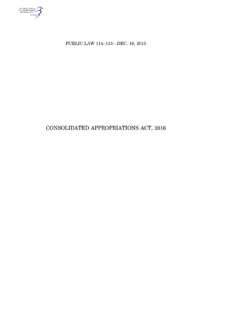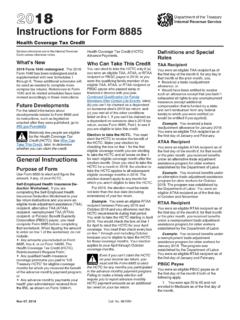Transcription of The Supplemental Nutrition Assistance Program (SNAP ...
1 The Supplemental Nutrition Assistance Program (SNAP): Categorical Eligibility Updated August 1, 2019. Congressional Research Service R42054. The Supplemental Nutrition Assistance Program (SNAP): Categorical Eligibility Summary The Supplemental Nutrition Assistance Program (SNAP) provides benefits to low-income, eligible households on an electronic benefit transfer (EBT) card; benefits can then be exchanged for foods at authorized retailers. SNAP reaches a large share of low-income households. In FY2018, a monthly average of million persons in million households participated in SNAP. Federal SNAP law provides two basic pathways for financial eligibility to the Program : (1) meeting Program -specific federal eligibility requirements; or (2) being automatically or categorically eligible for SNAP based on being eligible for or receiving benefits from other specified low-income Assistance programs.
2 Categorical eligibility eliminated the requirement that households who already met financial eligibility rules in one specified low-income Program go through another financial eligibility determination in SNAP. In its traditional form, categorical eligibility conveys SNAP eligibility based on household receipt of cash Assistance from Supplemental Security Income (SSI), the Temporary Assistance for Needy Families (TANF) block grant, or state-run General Assistance (GA) programs. However, since the 1996 welfare reform law, states have been able to expand categorical eligibility beyond its traditional bounds. That law created TANF to replace the Aid to Families with Dependent Children (AFDC) Program , which was a traditional cash Assistance Program .
3 TANF is a broad- purpose block grant that finances a wide range of social and human services. TANF gives states flexibility in meeting its goals, resulting in a wide variation of benefits and services offered among the states. SNAP allows states to convey categorical eligibility based on receipt of a TANF. benefit, not just TANF cash welfare. This provides states with the ability to convey categorical eligibility based on a wide range of benefits and services. TANF benefits other than cash Assistance typically are available to a broader range of households and at higher levels of income than are TANF cash Assistance benefits. As of July 2019, 42 jurisdictions have implemented what the Department of Agriculture (USDA) has called broad-based categorical eligibility.
4 These jurisdictions generally make all households with incomes below a state-determined income threshold eligible for SNAP. States do this by providing households with a low-cost TANF-funded benefit or service such as a brochure or referral to a telephone hotline. There are varying income eligibility thresholds within states that convey broad-based categorical eligibility, though no state may have a gross income limit above 200% of the federal poverty guidelines. In all but six of these jurisdictions, there is no asset test required for SNAP eligibility. Categorically eligible families bypass the regular SNAP asset limits. However, their net incomes (income after deductions for expenses) must still be low enough to qualify for a SNAP benefit.
5 That is, it is possible to be categorically eligible for SNAP. but have net income too high to actually receive a benefit. The exception to this is one- or two- person households that would still receive the minimum benefit. Neither the Agriculture Act of 2014 ( 2014 Farm Bill, 113-79) nor the Agriculture Improvement Act of 2018 ( 2018 Farm Bill, 115-334) made changes to SNAP categorical eligibility rules. In the 113th Congress, the House-passed version of the 2014 law would have eliminated broad-based categorical eligibility, but that change was not included in the conference agreement. In the 115th Congress, the House-passed version of the 2018 law would have made changes to limit but not eliminate broad-based categorical eligibility; these changes were not included in the conference agreement.
6 Congressional Research Service The Supplemental Nutrition Assistance Program (SNAP): Categorical Eligibility On July 24, 2019, the Trump Administration published a proposed rule to amend the categorical eligibility regulations, proposing to limit the TANF-funded benefits that may convey categorical eligibility. Congressional Research Service The Supplemental Nutrition Assistance Program (SNAP): Categorical Eligibility Contents Introduction .. 1. Regular and Categorical Eligibility for SNAP .. 1. Eligibility through Meeting Federal Income and Resource Tests .. 2. Categorical Eligibility .. 2. Early History .. 3. The 1996 Welfare Law and TANF .. 3. What TANF Means for Categorical Eligibility .. 4. Traditional, Narrow, and Broad-Based Categorical Eligibility.
7 5. Scope and Reach of Categorical Eligibility .. 5. Broad-Based Categorical Eligibility Practices .. 6. Incomes and Assets of SNAP Households .. 12. Income .. 12. Assets .. 14. Recent Proposals to Change Categorical 15. 2014 and 2018 Farm Bills .. 15. Trump Administration's Proposed Rule to Amend Categorical Eligibility .. 16. Summary of Proposed Rule .. 16. USDA's Estimate of Proposed Rule's Impact .. 18. Figures Figure 1. States Opting for SNAP Broad-Based Categorical Eligibility as of July 2019 .. 6. Tables Table 1. SNAP Broad-Based Categorical Eligibility by State .. 8. Table 2. Gross Incomes of SNAP Households Compared with Poverty: FY2016 .. 12. Table 3. Estimates of SNAP Households without an Elderly or Disabled Member with Gross Incomes Over 130% of Poverty by State, FY2016.
8 13. Contacts Author 19. Congressional Research Service The Supplemental Nutrition Assistance Program (SNAP): Categorical Eligibility Introduction The Supplemental Nutrition Assistance Program (SNAP) provided food Assistance to a monthly average of million persons in million households in FY2018. Total benefit costs were $ billion in FY2018. SNAP participation and costs increased markedly from FY2007 to FY2013, mostly as a result of automatic and legislated responses to the In FY2014, both participation and costs declined from peak FY2013 levels and have continued to decline. While much of the FY2007 to FY2013 increase in participation and costs was attributable to the poor economy, states during this period also increasingly adopted more expansive categorical eligibility rules a set of policies that make a SNAP applicant eligible based on the applicant's involvement with other low-income Assistance programs: benefits from the Temporary Assistance for Needy Families (TANF) block grant, Supplemental Security Income (SSI), and state-financed General Assistance (GA) programs.
9 This report discusses categorical eligibility and some of the issues raised by it. It first describes the three different types of categorical eligibility: traditional categorical eligibility conveyed through receipt of need-based cash Assistance , and the newer narrow and broad-based . categorical eligibilities conveyed via TANF noncash benefits. It also provides recent information on current state practices with regard to categorical eligibility. Under current law and regulation, it is a state option to implement broad-based categorical eligibility for SNAP. As a result, potential changes to curtail (or expand) categorical eligibility may impact some states more than others. This report includes state-by-state information to assist in gauging these disparate impacts.
10 SNAP is typically reauthorized in an omnibus farm bill law, and neither of the last two farm bills ultimately included changes to categorical eligibility rules. The Agriculture Act of 2014 (2014. Farm Bill, 113-79) made no changes to SNAP categorical eligibility rules. The House-passed version of the bill that became the 2014 Farm Bill would have eliminated narrow and broad- based categorical eligibility, retaining only traditional categorical eligibility for recipients of cash Assistance . However, the House-passed provision was not included in the bill's conference agreement. The most recent farm bill, Agriculture Improvement Act of 2018 ( 2018 Farm Bill, . 115-334) made no changes to SNAP categorical eligibility rules.















